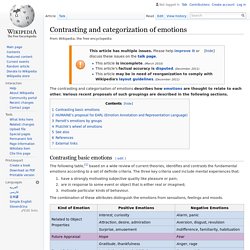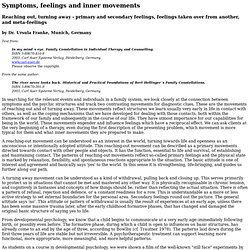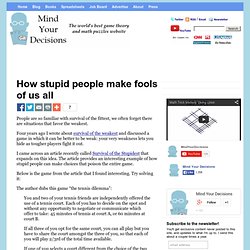

Contrasting and categorization of emotions. The contrasting and categorisation of emotions describes how emotions are thought to relate to each other.

Various recent proposals of such groupings are described in the following sections. Contrasting basic emotions[edit] The following table,[1] based on a wide review of current theories, identifies and contrasts the fundamental emotions according to a set of definite criteria. The three key criteria used include mental experiences that: have a strongly motivating subjective quality like pleasure or pain;are in response to some event or object that is either real or imagined;motivate particular kinds of behaviour.
The combination of these attributes distinguish the emotions from sensations, feelings and moods. HUMAINE's proposal for EARL (Emotion Annotation and Representation Language)[edit] The emotion annotation and representation language (EARL) proposed by the Human-Machine Interaction Network on Emotion (HUMAINE) classifies 48 emotions.[2] Parrott's emotions by groups[edit] Untitled. By Dr.

Ursula Franke, Munich, Germany Text from: In my mind´s eye. Family Constellation in Individual Therapy and Counselling. ISBN 3-89670-410-92003, Carl Auer Systeme Verlag, Heidelberg, Germany.www.carl-auer.dePlease observe the copyright. From the same author: The river never looks back. In searching for the relevant events and individuals in a family system, we look closely at the connection between symptoms and the psychic structures and track two contrasting movements for diagnostic clues.
A reaching-out movement can be understood as an interest in the world, turning towards life and openness as an unconscious or intentionally adopted attitude. A turning away movement can be understood as a kind of withdrawal, pulling back and closing up. From developmental psychology, we know that a child begins to communicate at a very early age–immediately following birth, or possibly even before. Symptoms are right. Ecologie spirituelle. Potlatch (anthropologie) Un article de Wikipédia, l'encyclopédie libre.

Pour les articles homonymes, voir Potlatch. Originellement, la culture du potlatch était pratiquée autant dans les tribus du monde amérindien (les Amériques) que dans de nombreuses ethnies de l'océan Pacifique, jusqu'aux Indes. C'est pourquoi les premiers colons européens ont pu considérablement spolier les indigènes qui pratiquaient le potlatch, car ils échangeaient de l'or contre de la bimbeloterie ; les Indiens croyant à la valeur « potlatch » de ces échanges pensaient que ces trocs étaient équilibrés. Dans la culture occidentale actuelle, on utilise aussi la formule « briller ou disparaître », qui reflète une dynamique de type potlatch, dans les contextes et cérémonies suivantes : Contribution aux repas communautaires, où chacun apporte spontanément un plat ou une boisson pour tous (salade, dessert...)
Le potlatch renvoie en philosophie à la notion de dépense pure (cf. Socio-constructivisme. How stupid people make fools of us all. People are so familiar with survival of the fittest, we often forget there are situations that favor the weakest.

Four years ago I wrote about survival of the weakest and discussed a game in which it can be better to be weak: your very weakness lets you hide as tougher players fight it out. I came across an article recently called Survival of the Stupidest that expands on this idea. The article provides an interesting example of how stupid people can make choices that poison the entire game. Below is the game from the article that I found interesting. Try solving it: The author dubs this game “the tennis dilemma”: You and two of your tennis friends are independently offered the use of a tennis court. You may not be sure how the others choose, but you might be able to think about it logically. First, examine the choice of court A: –If no one else picks A, then you get no playing time. And contrast this to choice B: –If no one else picks B, then you get no playing time. What’s the dilemma then? The Top 10 Psychology Studies of 2010.
The end of 2010 fast approaches, and I'm thrilled to have been asked by the editors of Psychology Today to write about the Top 10 psychology studies of the year. I've focused on studies that I personally feel stand out, not only as examples of great science, but even more importantly, as examples of how the science of psychology can improve our lives. Each study has a clear "take home" message, offering the reader an insight or a simple strategy they can use to reach their goals , strengthen their relationships, make better decisions, or become happier. If you extract the wisdom from these ten studies and apply them in your own life, 2011 just might be a very good year. 1) How to Break Bad Habits If you are trying to stop smoking , swearing, or chewing your nails, you have probably tried the strategy of distracting yourself - taking your mind off whatever it is you are trying not to do - to break the habit. J. 2) How to Make Everything Seem Easier J. 3) How To Manage Your Time Better M.
J. Accueil.